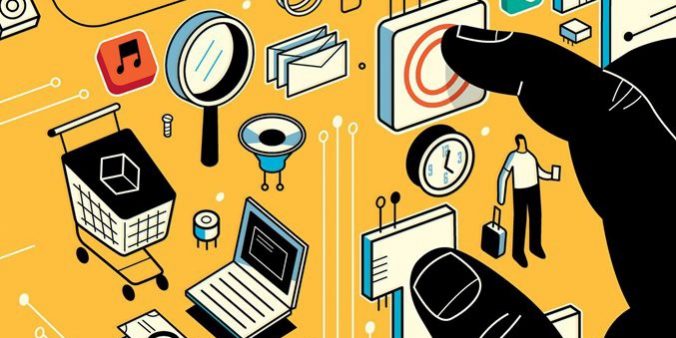The world has continued to move towards a digital future over the years. Technology is a large and integral part of life today, with multiple factors driving and enabling this change. As customers grow increasingly tech-savvy, they demand fast and seamless digital experiences and expect immediate solutions to their needs. In response, firms change the way they do business by accelerating technology and reinventing processes, organizational structures, and business models. By increasing investments in technology, firms can observe benefits such as lower costs and higher efficiency, and more capably meet stakeholders’ expectations. For instance, by digitizing its mortgage-application and decision process, a bank could reduce the cost per new mortgage by 70 percent and cut the preliminary approval time from several days to one minute (Markovitch & Willmott, 2014).
In the context of technology’s increasing importance, four “new-age technologies” — the Internet of Things (IoT), Artificial Intelligence (AI), Machine Learning (ML), and blockchain — are particularly noteworthy. According to Gartner’s Hype Cycle for Emerging Technologies, IoT, AI, ML, and blockchain are breakthrough or early expectation stages, with mainstream adoption predicted to occur several years into the future. For instance, AI and ML will be available to the masses, potentially fostering communities of developers, data scientists, and architects (Panetta, 2018).
These technologies are widely considered the way of the future and underlie other trends expected to gather steam in the years ahead. For instance,
- IoT and its abundance of smart, connected products are predicted to become more pervasive (Columbus, 2017; Montresor, 2014). The number of related things being estimated to increase to around 75 billion by 2020 (IHS, 2016).
- This growth in IoT is expected to impact automation and connectivity of processes and devices, contribute mainly to the datafication trend (Marr, 2017a), and lead to an increased investment focus on ML and AI-powered analytics (Dixon, 2016, Ihs, 2016).
- AI is being applied to varied contexts, from automating fact-checking in journalism to powering chatbots that interact with customers on e-commerce websites (Newman, 2017).
- In addition to its application to cryptocurrencies, blockchain is a foundational technology with potential applications in securing data and transactions in business, government, healthcare, content distribution, etc. (Council, 2018, Panetta, 2017).
While firms have been applying these new-age technologies to marketing activities and business tasks in isolation, they have only recently begun to examine these technologies’ integrated application to marketing strategies. There has been a noticeable shift towards data-driven business and marketing strategies, leading firms to harness the power of new-age technologies to spur all business units, especially marketing. The potential of new-age technologies to integrate data from varied sources and mine this data using sophisticated techniques to derive powerful insights has encouraged firms to examine new-age technologies keenly. Furthermore, firms are now beginning to comprehend the new business opportunities that these new-age technologies provide and apply them to solve existing problems or augment existing capabilities.
No longer can firms rely on engaging with their customers in isolated interactions; customers today expect effortless, intuitive, and seamless experiences across touchpoints. New-age technologies, if applied strategically, can enable firms to meet and even exceed these expectations. The future of marketing lies in firms’ efforts to acquire a holistic understanding of their customers’ needs and behaviors across platforms, devices, and various products and services. In this light, it is critical to study the impact of these four new-age technologies, specifically regarding marketing strategies, understand how they are currently being leveraged, and identify the potential areas that merit more in-depth exploration.
This study chooses IoT, AI, ML, and blockchain as the focal new-age technologies based on their future potential, interconnectivity, and data linkage. Through the rest of this study, we use the term “new-age technologies” to refer to these four technologies: IoT, AI, ML, and blockchain.
As more firms move towards the adoption of new-age technologies, the following questions are important from a marketing perspective:
- What do we currently know about the four focal new-age technologies — IoT, AI, ML, and blockchain?
- What do we currently know about the impact of these new-age technologies on firms and customers?
- In the future, what would we want to know about these new-age technologies, i.e., what specific research questions would we like to see answered?
We discuss the four focal new-age technologies’ salient elements and present research questions that hold the key to understanding their future potential. Our discussion is structured in the following manner. We begin by exploring prior research within marketing that has studied new-age technology adoption about IoT, AI, ML, and blockchain. We examine the elements of new-age technologies that are most important to firms and the domains in which they operate. Based on inputs from managerial interviews, we posit that each of these four new-age technologies has an orientation that grants the firm certain unique advantages and capabilities. The executive interviews also help us discuss the outcomes for firms and customers due to adopting new-age technologies. Based on managerial interviews, existing literature, and popular press discussions, we recognize the dynamic nature of new-age technologies and the current knowledge pool’s limitations. This leads us to identify directions for future research to expand our knowledge of new-age technologies.
Contact GrowSmart for all your Digital Marketing needs.








